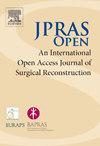Squamous cell carcinoma in rare case of Huriez Syndrome: The role of distant flaps
IF 1.5
Q3 SURGERY
引用次数: 0
Abstract
Context
Huriez syndrome is a rare de rmatological condition characterized by severe sclerotic and atrophic changes in the extremities (hands and feet) and an increased tendency to develop squamous cell carcinomas, with no established gold standard for the surgical treatment of these patients, who are difficult to manage due to the inability to perform reconstructions using local flaps.
Clinical Case
We report the case of a patient with severe Huriez syndrome who had developed SCC in both the hands and foot over time. After multiple surgeries at other centers, all resulting in recurrences, we planned wide excisions followed by reconstruction using distant flaps. The postoperative course for both reconstructive procedures was complication-free. Follow-up revealed not only an excellent reconstructive outcome but also highlighted the untapped potential of the flap in managing this condition: thanks to its independent vascularization, the flap remained unaffected by the surrounding diseased skin and significantly improved the scaly, atrophic appearance of the affected areas.
Discussion
Huriez syndrome is a dermatological condition characterized by a predisposition to developing squamous cell carcinomas. In these patients, it is essential to plan wide excisions that ensure oncological radicality. The reconstruction must be carefully planned, and microvascular flaps can be prioritized.
Conclusion
The radial forearm flap has proven effective for reconstruction in individuals with SCC associated with Huriez syndrome. The skin of the flap not only remained unaffected by the surrounding pathology but also induced a previously undescribed benefit on the diseased skin. This oncological-reconstructive approach could become the gold standard in treating these patients.
罕见赫里兹综合征的鳞状细胞癌:远端皮瓣的作用。
背景:Huriez综合征是一种罕见的皮肤疾病,其特征是四肢(手和脚)发生严重的硬化和萎缩变化,并有发展为鳞状细胞癌的趋势,这些患者的手术治疗没有既定的金标准,由于无法使用局部皮瓣进行重建,这些患者难以管理。临床病例:我们报告的情况下,病人严重的赫里兹综合征谁已经发展SCC在双手和脚随着时间的推移。在其他中心进行多次手术后,所有手术都导致复发,我们计划大面积切除,然后使用远处皮瓣重建。术后两种重建手术均无并发症。随访不仅显示了良好的重建结果,而且强调了皮瓣在治疗这种情况方面尚未开发的潜力:由于其独立的血管化,皮瓣不受周围病变皮肤的影响,并显着改善了受影响区域的鳞状萎缩外观。讨论:胡里兹综合征是一种皮肤病,其特点是易患鳞状细胞癌。在这些患者中,必须计划广泛的切除以确保肿瘤的根治性。重建必须仔细规划,微血管皮瓣可以优先考虑。结论:前臂桡侧皮瓣已被证明是有效的重建个体SCC与Huriez综合征。皮瓣的皮肤不仅不受周围病理的影响,而且还诱导了以前未描述的病变皮肤的益处。这种肿瘤重建方法可能成为治疗这些患者的黄金标准。
本文章由计算机程序翻译,如有差异,请以英文原文为准。
求助全文
约1分钟内获得全文
求助全文
来源期刊

JPRAS Open
Medicine-Surgery
CiteScore
1.60
自引率
0.00%
发文量
89
审稿时长
22 weeks
期刊介绍:
JPRAS Open is an international, open access journal dedicated to publishing case reports, short communications, and full-length articles. JPRAS Open will provide the most current source of information and references in plastic, reconstructive & aesthetic surgery. The Journal is based on the continued need to improve surgical care by providing highlights in general reconstructive surgery; cleft lip, palate and craniofacial surgery; head and neck surgery; skin cancer; breast surgery; hand surgery; lower limb trauma; burns; and aesthetic surgery. The Journal will provide authors with fast publication times.
 求助内容:
求助内容: 应助结果提醒方式:
应助结果提醒方式:


